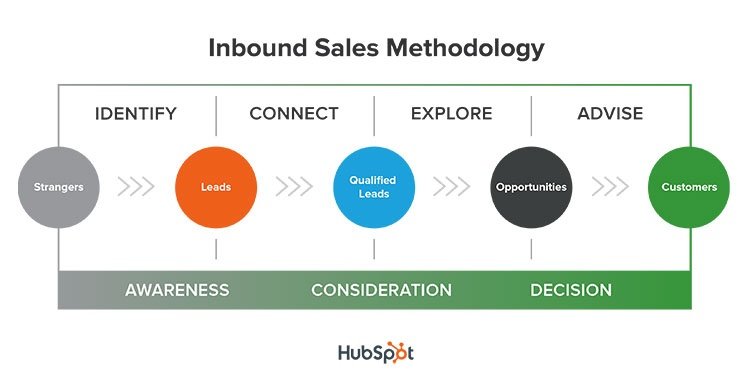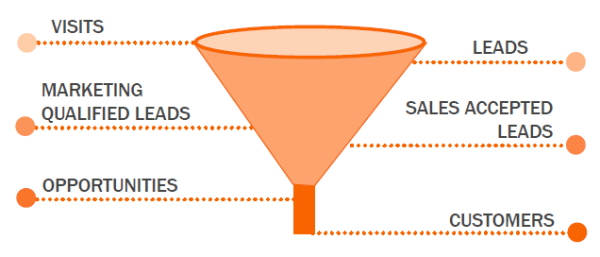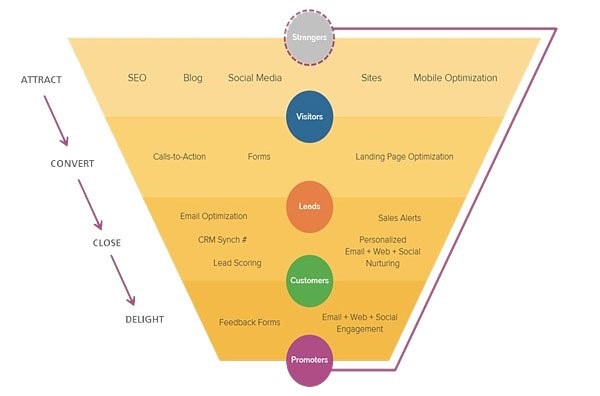Do you have a great company with superb services, yet you’re struggling to attract new customers? It’s probably not your product – it’s more likely an issue with your marketing strategy. This is where using an inbound marketing methodology can help. This strategy focuses on turning strangers into customers and building your brand presence.
Learn more about this strategy, and more importantly – why it works.
What Is Inbound Marketing?
Inbound marketing focuses on four key stages to better promote your business: Attract, Convert, Close and Delight. Each stage has specific methods to convert casual observers of your company into customers, and ultimately, brand promoters.
- Attract: This first stage attracts strangers through blogs, social media posts, keywords, and web pages.
- Convert: The next stage turns visitors into leads through calls-to-action, landing pages, lead forms, and contacts.
- Close: The third stage focuses on converting leads into customers. This can be done by sending email campaigns, creating workflows, conducting lead scoring, and integrating with a CRM.
- Delight: The final stage is to turn your customers into promoters of your brand. You can do this through social media posts, smart calls-to-action, emails, and workflows.

Why Inbound Marketing Methodology Works
Now that you know what inbound marketing is, it’s time to talk about the part you really care about – why this method works.
It increases your website traffic
Inbound marketing focuses on increasing your Search Engine Optimization (SEO) and your content marketing efforts with robust pages. Doing this can drive more targeted traffic — and qualified leads — to your website. Creating more content (like blogs, articles, and pages) tied to the specific keywords that are relevant to your customers can help increase your ranking on search engines, like Google.
It enhances your qualified leads
With inbound marketing methodology, you are not just creating content for the sake of producing content. Under this strategy, you are creating content to attract your targeted audience. To do this, you want to think about what your potential customers are interested in and what they might be searching for. This can include blogs on industry trends and how-to articles that can drive them to your site. Your audience now has a much better understanding of who you are and what products and services you provide, so they become a more qualified lead than someone who just clicked on an ad.
There is also another perk to creating good content – it can get picked up by other websites and publications. This puts your content in front of their audience as well, to attract more leads.

It allows you to show them what you do
When you publish engaging, quality content on your site, your leads will associate that same level of quality with your company. Your content also demonstrates your business’ expertise, and how your products and services can help your customers. This allows leads to have a clear understanding of what you do, why you do it, and how you do it.
It lets you control the content and the costs
Inbound marketing can be a cost-effective way to promote your brand. When you run an ad, you need to pay for the ad spot and the creative. With content, you can likely create it in-house. It will only cost time. Plus, you own the content, so you can keep it on your site and reuse it as you need it. You can use one blog on your website, in social posts, emails, and more. This makes inbound marketing campaigns more effective than outbound campaigns – getting as much as three times the ROI on inbound campaigns, according to HubSpot.
It helps you build relationships with your customers
Inbound marketing methodology involves creating quality, relevant and useful content that will help your customers – and potential customers – do their jobs better. This content helps them learn to turn to you when they need answers. They will start to build a relationship with your company and will become loyal to your brand. Engaging with customers on social media and reading and responding to any comments they leave on your content will also help enhance this relationship.
It moves leads through your funnel faster
When you make a new purchase, you likely research the product first, right? So, if we do it, then we should expect our customers to do the same thing. Inbound marketing methodology accounts for this and helps you capture leads and move them through the sales funnel by offering targeted content at various stages. For example, you might provide general product information and calls to action to those at the top of the funnel. Then at the middle of the funnel, you might provide content specific to your company’s products and services and encourage them to fill out a lead form or subscribe to your blog or a newsletter. And finally, you might provide pricing information to those who are at the bottom of the funnel and are close to closing a deal.

It provides you with metrics to measure your marketing efforts are working
One of the hardest parts about marketing is showing your ROI. Inbound marketing can resolve this. This strategy allows you to get measurable results on your campaigns, website, and individual content items. You can pull metrics through Google Analytics to get page views, the amount of time people spend on your site and demographics on your visitors. You can also use your CRM, like HubSpot, to track information on your campaigns.
While it can take some planning to execute an effective inbound marketing strategy, it can be very effective in turning strangers into customers. If you need help getting started, contact Lake One to help you create your inbound marketing strategy, execute it, and measure it!


